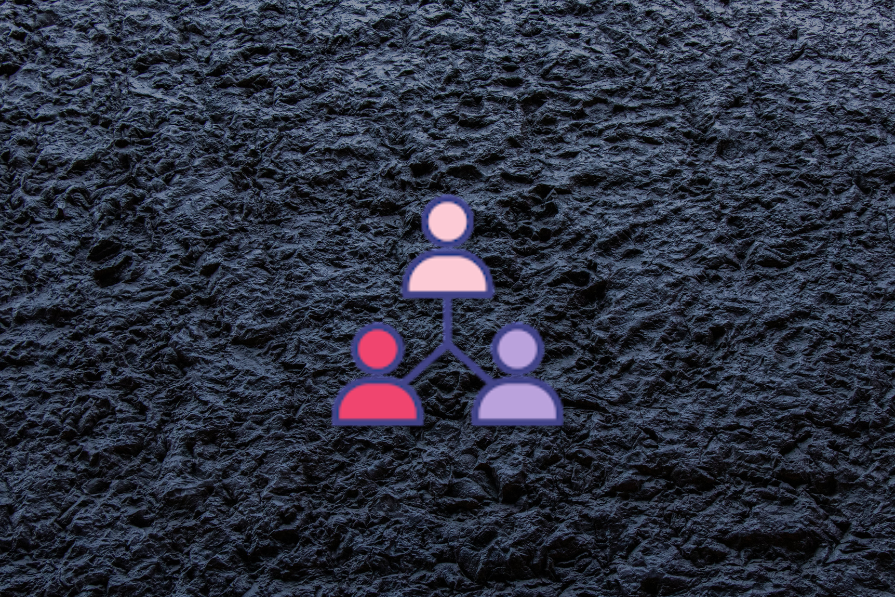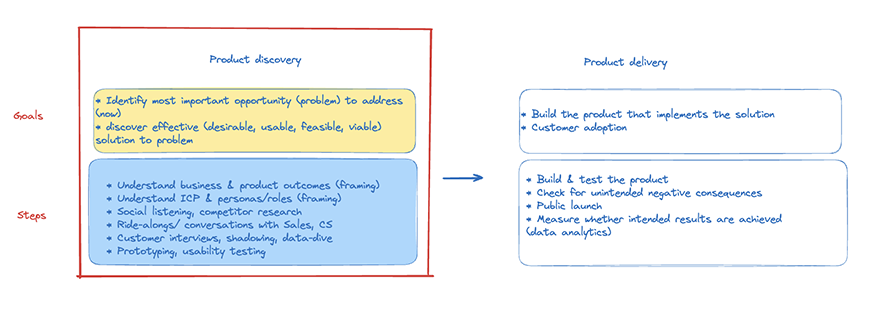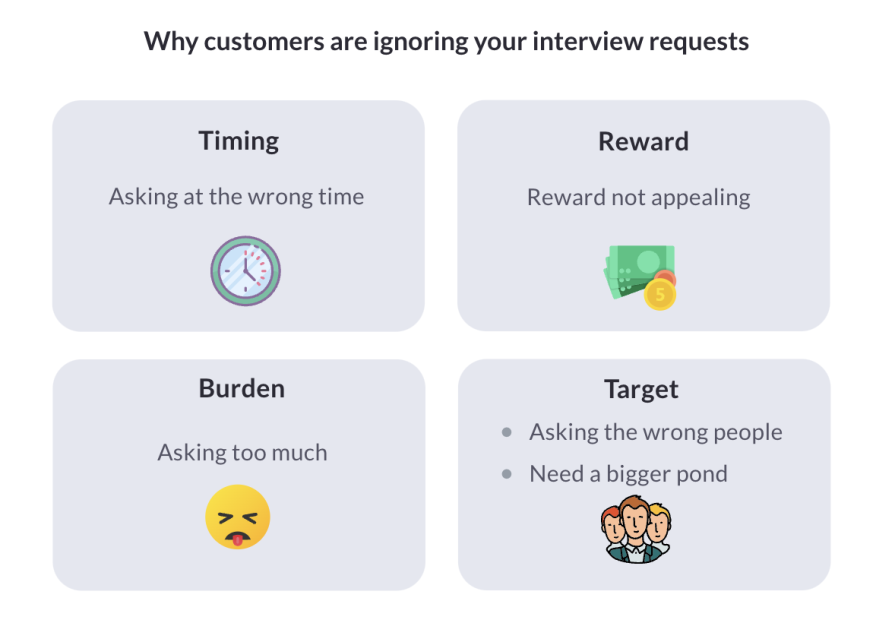Meet Kathy. Kathy is a product manager at a small B2B SaaS tech company. Ever since reading Teresa Torres’ Continuous Discovery Habits, she’s been obsessed with talking to customers. After working tirelessly for months, she finally crossed her main internal hurdle and got the green light to start reaching out to customers, even promising them a $100 reward. Off to the races!

Kathy sends a beautifully worded email campaign, explaining how this interview would help her so very much, expressing her undying gratitude for even opening the email, and, of course, her email scheduling link.
But…to no avail. Exactly zero interviews are scheduled, and five percent of customers hit unsubscribe…
Sadly, this is not an uncommon scenario for B2B startups. Startups with fewer than 500 customers and startups targeting niche target audiences especially have a hard time.
In this article, I’ll troubleshoot the five most common issues that block product trios from even getting started with interviewing customers continuously.
For those of you who haven’t read the book, do it now!
“At a minimum, weekly touchpoints with customer by the team building the product where they conduct small research activities in pursuit of a desired outcome.” (Definition by Teresa Torres)
Most product managers act as glorified project managers. They’re “stuck” in the delivery realm, simply translating requests from leadership, sales, or CS into features. You can blame HiPPo’s, the curse of being sales-led, agile, or whatever else. Success is measured in “How many story points can we push through per sprint?” or “Are we meeting our deadlines?”
But neither of these correspond at all to whether a business is doing well. Velocity actually hurts you if you’re building the wrong features.
Marty Cagan turned the product world upside down with his book Inspired in 2008 (followed by several other PM must-reads). He asked himself what great product companies do differently from normal ones, and found two things:

Teresa Torres picked up Marty’s line of thinking in her book, providing a practical framework for how to conduct interviews continuously and generate insights from those interviews.
Most companies speak to customers two or (maximum) three times per year, in concentrated bursts, often on a project basis.
“We’re considering implementing a new AI conversational bot, so we’re talking to 10 customers to ask them about their experiences with AI conversational bots.”
Speaking to customers every week is better for many reasons:
So, now you’re all caught up and hopefully convinced that continuous discovery is a good idea. Let’s get to the stumbling blocks…
A classic — especially for small B2B companies that have only a small pond to fish from, and that pond happens to be filled with busy, hard-to-reach, high-maintenance fish.
These are the four reasons why customers might be ignoring your pleading interview requests:

E-mails are problematic:

Such a sweet email. Still, I’m unlikely to open it, let alone take action.
Tools like Userpilot or Crisp (detailed below) allow you to trigger an in-app pop-up to customers so that you can reach them while they’re actively thinking about your product.
A study by Reckless Agency found that in-app messaging sees open rates of 75 percent. That’s 45x (!!) higher open rate than email, and 3x higher than push notifications. You’d be silly not to capitalize on that.
Reflect on all the steps you’re asking your customer to take when you ask them to participate in an interview to see where you can lighten the load.
For one of my clients, I installed Crisp, a live chat tool that comes with a chatbot in their unlimited package at €95 per month:

We don’t only use Crisp to allow customers to reach out to us, but also to talk to customers that appear to be good interview candidates. If a paying customer triggers a certain value event, Crisp’s bot automatically pops up and asks for a quick, immediate interview. If we get a yes, a product manager is notified and able to manually intervene.
The benefit of this is that we reach customers at the moment that they’re thinking about our product and allow them to talk to us immediately, rather than having to schedule something in the future.
Don’t get me wrong. I strongly prefer doing 1:1 interviews in a video call setting. Face-to-face conversations are the best (only?) setting for open, free-flowing conversations. However, it’s better to have less-than-ideal interviews than no interviews at all.
If no one is signing or showing up for your interviews, and you suspect that lowering the barrier to entry will help, then that’s what you should do.
It’s rarely the rewards that block a successful transaction with B2B customers. Your B2B customers are likely busy people with lives, obligations, and motivations of their own. Offering $50 or $100 is probably not going to move the needle.
That being said, through discovery and experimentation, you might stumble upon something that does sweeten the deal for your target customer. For example, a month of using your product for free, a free upgrade to the next tier, or something entirely different.
As always, what works is target audience-dependent. There’s no one-size-fits-all answer.
Starting a weekly interview cadence with 10 paying customers means that, even if you have a 100 percent interview signup rate, you’ll have to start repeating customers after 10 weeks.
Speaking to customers more than once is not necessarily a bad thing. You’ll be able to change the scope or explore different opportunities during each interview. However, if you speak to only a small group of customers repeatedly, you’re at risk of creating a product that fits this small group but fails to meet the needs of your target audience.
The answer? Audience interviews.
You can recruit interviewees outside of your customer base as long as they fit your ICP. But never forget that you’re missing an important step of self-selection here: these aren’t the people who chose your tool.
I use LinkedIn, conferences, and meetups to recruit for audience interviews.
If you spend your days perfecting Jira tickets, participating in scrum events, or putting out production fires, how on earth are you going to squeeze in speaking to customers regularly?
I feel you, but this is a prioritization issue. Scroll back to the first section about continuous discovery where I described why you should shift your mindset from pushing out features (output) to creating a product that brings value to your customers (outcome).
If you don’t have time, make time.
Yes, if you want to do things by the book, you need at least a product designer and an engineer to join your product trio. However, if no one else in your organization (including leadership) is convinced, good luck getting anyone on board.
Just start anyway.
Once you’re able to share some first insights that spark new conversations and ideas, you might be able to create some excitement. The more insights you can share, the greater the buy-in will become.
Especially in B2B, where client relationships are super important, it’s not uncommon for product managers to be blocked from speaking to customers.
“You’re in the tech department, product/tech shouldn’t talk to customers.” “Each of our customers get one point of contact, their key account manager, and all communication must go through them.”
I’ve heard them all before.
The intentions are good — we don’t want to harass customers with communication from all sides, we want to treat them with respect and care.
But the way product managers and researchers talk to customers is different from the way sales or customer support agents do.
It’s our job and skill set to get the most truth and value out of conversations and to dig beneath feature requests for underlying problems or desires. This is why it’s important for us to have that direct line, and this is why we should never give up:

On the other hand, it never helps to kick off an ideological debate about “the right way of doing product.” Nobody cares.
But what your leadership team does care about is outcomes, which can come in the form of useful insights.
On the one hand, you need to alleviate the fears or concerns that are keeping your colleagues from letting you talk to customers. On the other hand, you need to show results fast.
So here’s how you break through the barrier:
It takes time and persistence to create a habit. What helps is to pin yourself down with a fixed schedule.
For example this schedule suggested by Jeff Gothelf in his article “How 3 startups built their customer discovery practice:
Now that you’re fully unblocked, one last word of advice: only talk to customers (or audience members) that fit your ICP! If you stray outside of your ICP, you’re likely to collect more noise than signal. Happy interviewing!
Featured image source: IconScout

LogRocket identifies friction points in the user experience so you can make informed decisions about product and design changes that must happen to hit your goals.
With LogRocket, you can understand the scope of the issues affecting your product and prioritize the changes that need to be made. LogRocket simplifies workflows by allowing Engineering, Product, UX, and Design teams to work from the same data as you, eliminating any confusion about what needs to be done.
Get your teams on the same page — try LogRocket today.

A practical framework for PMs to use AI in ideation without sacrificing judgment, strategy, or decision quality.

A practical five minute revenue estimation method to help product managers compare ideas, drop low impact features, and prioritize smarter.

A practical guide for PMs who want to stop being bottlenecks, delegate smarter, and lead teams effectively with a clear ownership framework.

Stop letting unreliable data block features. Treat data as inventory to track quality, ownership, and ship with confidence.